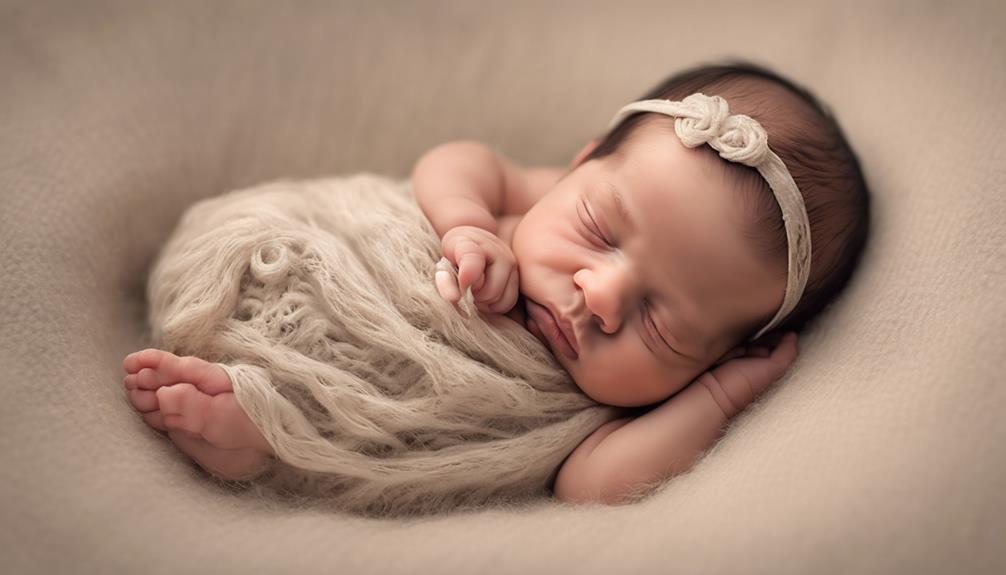When it comes to getting our newborn to sleep in a bassinet, it can feel like trying to fit a square peg into a round hole. We all know how important it is to establish healthy sleep habits, but getting there can be a challenge.
Let's explore some effective strategies that can help ease this change and guarantee peaceful nights for both baby and parents alike.
Key Takeaways
- Establish consistent bedtime routine and environment for smooth transition to bassinet sleep.
- Utilize swaddling techniques to reduce startle reflex and promote comfort in the bassinet.
- Create a calming environment with white noise and soft sounds to encourage peaceful sleep.
- Gradually introduce the bassinet for naps in a quiet, dimly lit room to familiarize your newborn with the sleep space.
Why Newborns Resist Bassinets
Newborns often resist sleeping in bassinets due to their natural instinct for contact napping and the comfort of being close to their caregivers. The room temperature plays a significant role as well; if it's too hot or too cold, they might find it uncomfortable and resist settling in their bassinet. Additionally, a dirty diaper can cause discomfort, making it harder for newborns to relax in their sleeping space.
Sometimes, issues like acid reflux can make lying flat in a bassinet uncomfortable for newborns, leading them to resist sleeping there. Understanding their wake windows is crucial too; overtiredness can make it challenging for them to fall asleep in a bassinet. Moreover, if babies are used to being held or rocked to sleep, they may resist the stillness of a bassinet.
Recognizing these reasons can help parents address their newborns' resistance to bassinets effectively. By creating a cozy sleep environment and addressing these factors, caregivers can help their little ones feel more comfortable and secure in their bassinets.
Creating a Cozy Sleep Environment

Creating a cozy sleep environment for your newborn in the bassinet is essential for promoting restful and safe sleep. To make sure your little one sleeps soundly, consider the following tips:
| Aspect | Recommendation |
|---|---|
| Firm Mattress | Use a firm, flat mattress to meet safe sleep guidelines for newborns. |
| Breathable Bedding | Opt for breathable bedding and avoid loose blankets or toys in the bassinet. |
| Room Temperature | Maintain a comfortable room temperature between 68-72 degrees Fahrenheit. |
| White Noise Machine | Utilize a white noise machine or gentle music to create a soothing environment. |
| Bedtime Routine | Establish a bedtime routine to signal to your baby that it's time to sleep. |
Strategies for Bassinet Success

To guarantee successful bassinet sleep for your newborn, it's important to establish a consistent bedtime routine that promotes a familiar and soothing sleep environment. Begin by incorporating swaddling techniques to help your little one feel secure and calm as they shift to the bassinet. Utilizing white noise or soft sounds can further enhance the soothing atmosphere in the bassinet, aiding in better sleep for your newborn. Gradually introducing the bassinet for naps during the day can help familiarize your baby with the sleeping space, making bedtime changes smoother.
When setting up the bassinet, make it's placed in a quiet, dimly lit room to create a peaceful sleep environment for your little one. Consistency is key in helping your newborn associate the bassinet with sleep and comfort. By following these strategies and creating a comforting sleep environment, you can increase the chances of your baby sleeping soundly in the bassinet.
Overcoming Common Sleep Challenges

Handling common sleep challenges with your newborn in the bassinet can be a challenging task, but with the right strategies, you can help your baby achieve restful sleep.
Swaddling your newborn baby can reduce the startle reflex, promoting better sleep in the bassinet.
Addressing discomforts like gas or acid reflux promptly can greatly improve your newborn's sleep quality.
Monitoring wake windows and ensuring your baby doesn't get overtired can also enhance their ability to settle down in the bassinet for peaceful rest.
Breaking existing sleep associations and habits may be necessary to switch your baby successfully to sleeping in the bassinet.
Establishing a consistent bedtime routine and environment can create a comforting atmosphere that encourages your newborn to sleep well in the bassinet.
Ensuring Peaceful Sleep for Baby

Establishing a consistent bedtime routine signals to your newborn that it's time to wind down and get ready for peaceful sleep in the bassinet.
Start by creating a calming environment with swaddling and white noise to help your baby feel secure and relaxed.
Encouraging important sleep habits is essential; try placing your little one in the bassinet drowsy but awake.
Remember, it's important to avoid introducing sleep training too early and focus on gentle settling methods instead.
Utilize pacifiers and gradual independence practices to assist your newborn in sleeping peacefully in the bassinet.
By incorporating these strategies, you can help your baby establish a healthy sleep routine and promote a restful environment for both you and your little one.
Prioritizing a peaceful sleep environment not only benefits your newborn but also contributes to your well-being by ensuring you both get the rest you need.
Conclusion
As we navigate the journey of getting our newborns to sleep in a bassinet, remember that we're all in this together.
Just like a gentle lullaby can soothe a restless baby, our patience and consistency will guide them to peaceful slumber.
Embrace the ups and downs, knowing that each night brings us closer to a harmonious bedtime routine.
Let's continue to create a cozy oasis for our little ones, filled with love and tranquility.










